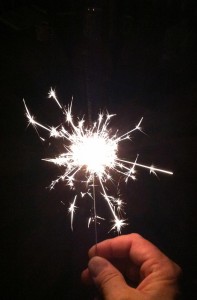Bright, Beautiful and 2,000 Degrees
This Fourth of July, Avoid Injuries from Fireworks

They are bright, beautiful, sparkly and fun to watch — but fireworks can injure you. According to the U.S. Consumer Product Safety Commission (CPSC) more than 9,000 fireworks-related injuries occur each year.
The CPSC said that of all fireworks-related injuries, 70 to 75 percent occur during the 30-day period around the July 4th holiday. The injury rate is highest among boys aged 10 to 14 years old. John Griswold, M.D., Texas Tech Physicians—Surgery and medical director of the Timothy J. Harnar Burn Center, said many parents feel sparklers are innocent and cannot harm a child. But for children under the age of five, sparklers account for one-third of all fireworks injuries.
“Remember that sparklers can burn at almost 2,000 degrees Fahrenheit, which is as hot as a burning charcoal grill fire and hot enough to quickly cause a third-degree burn if not handled correctly,” Griswold said.
He said most injuries from fireworks affect the hands, face and eyes. The third-degree burns tend to be small but extremely deep. Griswold said if you do get a burn do the following:
- Extinguish any flames or get away from any fires. If a fire does start, call 9-1-1.
- Rinse the area with cool water only. Do not soak the burn. Cover it with a clean, dry towel or gauze.
- Go to the nearest emergency center or urgent care center immediately.
Kelly Mitchell, M.D., Texas Tech Physicians — Eye Clinic said nearly 30 percent of fireworks injuries occur to the eyes.

“One-fourth of fireworks eye injuries result in permanent vision loss or blindness,” Mitchell said. “Children are the most common victims of firework accidents, with those fifteen years old or younger accounting for half of all fireworks eye injuries in the U.S.”
For a safe and healthy Independence Day celebration, the American Academy of Ophthalmology gives the following fireworks safety tips:
- Always wear protective eyewear if you are using fireworks
- Never let children play with fireworks of any type
- View fireworks from a safe distance at least 500 feet away or up to a quarter of a mile for best viewing
- Follow directives given by event ushers or public safety personnel
- If you find unexploded fireworks remains, do not touch them
According to Mitchell, if you do injure your eye, do not put pressure on it or rub
it. The best thing is to promptly get to a physician or hospital for care.
“Almost all eye injuries from fireworks are preventable,” Mitchell said. “Take precautions to keep your family safe to have a wonderful holiday.”
Related Stories
Celebrating Veterans: TTUHSC’s General Martin Clay’s Legacy of Service and Leadership
From his initial enlistment in the Army National Guard 36 years ago to his leadership in military and civilian health care management roles, Major General Martin Clay’s career has been shaped by adaptability, mission focus and service to others.
Texas Tech University Health Sciences Center School of Nursing Named Best Accelerated Bachelor of Science in Nursing Program in Texas
The TTUHSC School of Nursing Accelerated Bachelor of Science in Nursing (BSN) program has been ranked the No. 1 accelerated nursing program in Texas by RegisteredNursing.org.
TTUHSC Names New Regional Dean for the School of Nursing
Louise Rice, DNP, RN, has been named regional dean of the TTUHSC School of Nursing on the Amarillo campus.
Recent Stories
TTUHSC’s Hudson Set to Serve as President for Society of Clinical Research Associates
The Society of Clinical Research Associates (SOCRA) has elected Texas Tech University Health Sciences Center’s (TTUHSC) Catherine Hudson, Dr.P.H., as its president for 2025-2026.
Clinical Research Institute a Source of Pride for Retiring Griswold
Upon his retirement, John Griswold, M.D., reflects on the Clinical Research Institute and what it has achieved.
Abid Brings Hematology Expertise to TTUHSC Oncology Team
Muhammad Bilal Abid, M.D., has joined the TTUHSC School of Medicine oncology team as an associate professor of internal medicine and medical director of TTUHSC’s Blood and Marrow Transplantation & Cellular Therapy Program.
